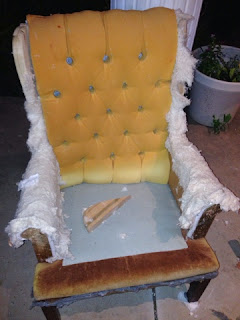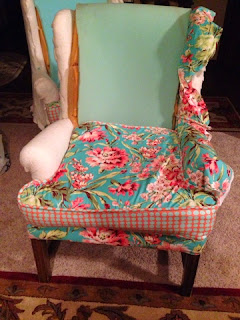Extreme Chair Makeover: An Adventure in Reupholstering
When my dad was in college, he had to take a class where he reupholstered a chair. Having experience in upholstery, when mom and I decided to take on this project we ask him if he had any advice for us. His advise was to take it to someone and not do it yourself. While mom and I did not know what we were getting ourselves into, we managed to successfully give these chairs a facelift. The chairs we reupholstered used to be my grandparents. They were in good shape for being previous residents of our attic.
The first obstacle we faced was finding the fabric we wanted to use. We went back and forth on this because we had trouble finding fabric that was vibrant and the quality fabric we needed for the job. After not having any luck finding the fabric we were looking for, we took a leap. We had seen fabric from Amy Butler's Love collection that we kept going back to; the problem was that it was not upholstery fabric. Having used Amy Butler fabric many times before we knew it was a high quality quilting fabric. Despite not being a true upholstering fabric, we decided to use it anyways. To reenforce the fabric interfacing was ironed to the fabric to give it a little extra support. It might not last as long as a true upholstery fabric would, but for what we want now it worked great.
Before the process began it is important to have the necessary tools and supplies. Some you will find out as you go; each chair will have its own quirks. Even though both of the chairs we were upholstering were identical, they had slight differences as we took them apart. As you take apart the chair carefully label little parts like cardboard pieces and fabric pieces as well. This was you can know if you need to replace them or reuse them. This will depend on the condition of the chair. Taking pictures as you go will also be helpful to remember how the chair should be put back together. It is important you are up to date on your tetanus shot and also have safety goggles. I did not have much trouble with the bleeding part, but mom left her mark at almost every major stage of the process. The goggles are a good idea to be on the safe side. Investing in a staple gun that attaches to an air compressor is also a good idea. Your hands will thank you. The most valuable took mom and I used for task such as getting fabric into crevasses to a back scratcher, was a cake spatula. Normally, this kind of spatula is used to spread icing on cake, but it had many purposes for us; this was truly the greatest idea we had during this project.
This is what the chairs first looked like. They are pretty old and had been in out attic for a while, but in good shape.
The first step was to label each part of the chair. By labeling the pieces before we took the chair apart, we were able to later have a pattern for the new fabric. The abbreviations can be anything that you can remember. Also remember to include an arrow so you know which part is the top.
We then began to take the chair apart by starting at the bottom. From this point on, you take apart the chair based off of each chairs quirks. What I mean by this is that we had two identical chairs and they both had been originally upholstered differently. So depending on the chair will determine how the following steps occur. To take the staples out of the chair we were using pliers and screw drivers. Between mom and I we had two of three different sized screw drivers and needle-nose pliers.
Next, we took the back piece of fabric off of the chair.
Moving to the arm of the chair, these buttons were the next to go. They popped right off with the help of a screw driver.
The decorative buttons that you just took of are there more or less as decoration and to cover staples. Take the staples out that were being covered and then take the piece of fabric off. There will be multiple layers that will need to be taken off.
After taking the front part of the arm off we moved to the side of the chair/arm.
Any pieces of cardboard, metal or cardboard stripes that you may run into save and label. Saving and labeling them can be useful if the pieces can be reused or to know what materials may be needed.
To continue taking the original fabric, the chair may need to be turned onto its side. The next part to take off will be the outside of the wing of the chair.
Metal pieces like these can be found at the top part of the wing of the chair. Save them to reuse when putting on the new fabric.
After both sides of the wings are taken off, take of the center front cushion piece.
When able, take of the cardboard piece on both sides.
Here you should be getting close to the bare wood of the chair.
After taking off the original upholstery, take off the batting that was between the wood of the chair and the fabric.


After taking off all of the original upholstery, we then covered the chair
in an upholstery foam. We used an inch thick foam on the inside part of
the chair and a half inch foam on the outside. Later the foam was
covered in batting. The batting also gives a smother look to the chair
when putting on the new fabric to the chair.
The first piece of new fabric we put on the chair was the bottom front piece shown. We left the original part with the old fabric on because it was in good shape and covered it. The floral fabric was sewn to white fabric that covers the part of the chair under the cushion.
Mom then made the cushions. The process for the cushions is similar to how a pillow would be made.
To begin to cover the chair with the new fabric, we began with the arms. The new fabric was cut using the old pieces that had been labeled and taken off earlier. They were cut larger than original piece to be sized down later.The first piece we covered was the inside of the arms.


After attaching the inside of the arm, we stapled the cording to the chair. The cording was stapled from the top of the chair to the end of the arm.
Once the cording was stapled, the top part of the arm was put on. After the top of the arm was put on the part under the arm was put on. The cardboard strips were used to get a straight line with the fabric.
At this point, we had the front, back, and bottom left on the chair. Before putting the remaining fabric left onto the chair, we covered the front with batting.
We put the front piece of fabric on the chair. Since we were doing two chairs we compared them to see of the fabrics prints matched each other. Also when the fabric was cut we did our best to match the pieces with the print. The fabric we used is busy enough this was not a huge concern, but with other fabrics it can be more of an issue. To get the fabric where it needed to be the cake spatula was VERY useful here.
While this chair looks complete, we still had some more work left...
The piece of the chair was put on with this contraption. Starting at the top we got the fabric with the teeth into the chair and then used a mallet to secure it.
Now all of the chair was covered in the new fabric. To give it a cleaner look we stapled cording to the bottom it the chair to cover it.
Again to give it a cleaner look and cover the bottom of the chair, we used a duck cloth on the bottom.
The last step was covering the raw edges on the front portion of the arm. To do this we cut the piece bigger than the original one was and then hot glued cording to it. We then glued a piece of cardboard to the back with tacks used on back piece of fabric between the fabric and cardboard. With upholstery glue on the cardboard. We put it on the chair and used a mallet to secure it. On the curve of the piece we put some hot glue to keep it in place.
After letting everything dry this was the final result!
Three weeks, blood, sweat, and fears we would never finish later the transformation was complete.
Mom and I are happy with how they turned out and glad to be finished! Upholstery is an adventure and while it comes with hard work it is possible.
Your Favorite Redhead
















































